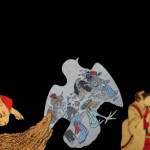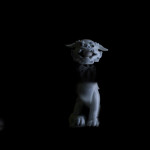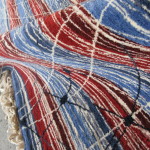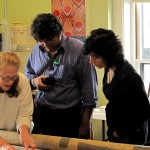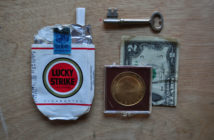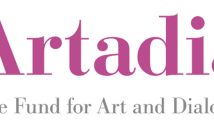A colorful, woven rug, cross-hatched with the patterns of communication between and from the Raqs' computers, awaits a bare-footed public to animate it with its own conversations and debates. Some prompting may be needed to encourage the type of exchange the Raqs Media Collective have honed through years of collaborative practice. Somewhat intimidatingly, a 17th century Japanese screen representing Confucius, Laozi and Buddha, hangs behind the mat, both to hint at its purpose and to mirror the interaction of the artists themselves. The philosophers' diverging views on the taste of vinegar (is it bitter, sweet or sour?) invites the audience to speak its mind through dialectical exchange rather than defensive debate – the three artists emphasized the natural tendency a trio has towards upsetting polarities of opinion. The quality of conversation called for shouldn't be a tall order for a population with as much brainpower per square block as Boston's, but it may very well prove to be for a contemporary art space where, typically, conversations are whispered and opinions are reserved, or conversely are quickly formed through visits all too hurried.
The idea is truly beautiful and the Collective has curated a series of talks between people who have points of view to make known on topics such as the effect of nostalgia, the reason for music, the need for intelligence. It is difficult to speak to the strength of The Great Bare Mat project without having yet listened in on one of these exchanges – but already, through its tapestry-like quality and through how it has been charged by the Raqs' mission for it, in part with its title, it seems to radiate a promise of communal warmth, intellectual frenzy and perhaps even enlightenment.
The mat's bareness in the first gallery is underscored by the silence in the second. Two pieces hang in darkness just above eye-level. On a backlit screen, angled into the room from one of its far corners, hovers an animated video. On the wall opposite, a dramatically lit puzzle of palely tinted glass casts figurative shadows of itself. The cynical reader may smile: both works, enveloped in the stillness and height of the space, awaken an almost spiritual reverence.
Given their chosen name, it isn't a stretch to claim that Raqs invoke mysticism with their work, reminding us that intuitive and intellectual postures may not have to be as mutually exclusive as we tend to believe. The most striking experience they recall from their two years at the Gardner was a midnight tour of the galleries by flashlight. The video that resulted animates characters photographically gathered from the collection's artworks, textiles, books and manuscripts, removing them from their original context to create a cosmogony of and for the Museum. Breathing life into static pieces through digital animation, the artists upset the provenance of these chimeric animals, allowing them instead to act out roles in a parallel and magical mythology of the Gardner collection.
This video reminded me of a 16mm film by British artists Rosalind Nashashibi and Lucy Skaer, recently included in the Metropolitan Museum's Spies in the House of Art. Flash in the Metropolitan forensically pulled statues out of the shadow of nighttime galleries through sudden illumination by a blinding strobe – eerie retinal persistence caused stone heads and bodies to hover in mid-air while the camera tracked on in the darkness to its next invisible subject. Here, the mood is less haunting and more whimsical – the creatures shape-shift across the screen and through their actions playfully build a loose narrative that touches on parade and revelry. Time collapses through the co-existence of objects that never were intended to stand side-by-side in the world, that is until Isabella Stewart Gardner imagined Fenway Court. The Gardner palace has in its own way become staid - artworks never moving, always to be found in the same place - which stands as a good reason for its treasures to be revisited by contemporary artists. Raqs Media Collective's vision at the Gardner is elegant and mysterious while never forgetting the larger ideas provoked by the peculiar place these are preserved in.
Where does nostalgia take us? I wasn't present to hear the answers offered from the four corners of the Great Bare Mat, but to open up the conversation I'll venture this: nostalgia makes it harder to see the present for the past, caught as we are in narratives of what was, and we must make time to recognize its potency lest we allow it too much agency to shape our future.
- Raqs Media Collective. Video Still. 2012
- Raqs Media Collective. Video Still. 2012
- Raqs Media Collective. Video Still. 2012
- Raqs Media Collective. Detail of the Great Bare Mat. 2012
- Jeebesh Bagchi (left), Monica Narula and Shuddhabrata Sengupta (back) photographed on Saturday, 13 February 2010 in New Delhi. (Photo Jatinder Marwaha)
- Textile Conservator, Tess Fredette, showing Raqs Media Collective a Bengali wall hanging of a triumphal arch from the mid-17th century, 2010 Photo courtesy of the Isabella Stewart Gardner Museum
- Anne-Marie Eze, Andrew W. Mellon Postdoctoral Curatorial Fellow, and Shuddhabrata Sengupta looking at an edition of Dante’s Divine Comedy, 2010 Photo courtesy of the Isabella Stewart Gardner Museum
- Flash in the Metropolitan Rosalind Nashashibi and Lucy Skaer Film strip. 2006. 16mm, color, silent, 3’25” Photo courtesy of the artists and The Metropolitan Museum of Art
Formed in 1992, Raqs Media Collective is Monica Narula, Jeebesh Bagchi and Shuddhabrata Sengupta. Based in Delhi, India, they have had solo exhibitions at The Tate Britain and Frith Street Gallery in London; Palais des Beaux Arts, Brussels; Asia Art Archive, Hong Kong, the Walker Art Center, Minneapolis, The Taipei, Liverpool, Ogaki and Venice Biennales, as well as curated "The Rest of Now" and co-curated "Scenarios" for Manifesta 7 (2008).
Raqs Media Collective at the Gardner
"The Great Bare Mat & Constellation" is on view September 20, 2012 to January 7, 2013 in the Gardner's Special Exhibition Gallery.
Upcoming conversations on the Great Bare Mat include:
October 25 at 7:00 PM
The Great Bare Mat Exchange: What Does Intelligence Do For Us?
November 3 at 1:00 PM
The Great Bare Mat Exchange: What Does Accumulation Do To Us?
December 8 at 1:00 PM
The Great Bare Mat Exchange: Why Does Music Move Us?
Tickets include museum admission, but are limited and must be reserved in advance.
All images are courtesy of Raqs Media Collective and the Isabella Stewart Gardner Museum.


